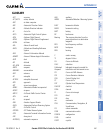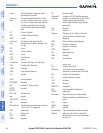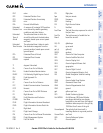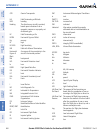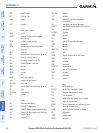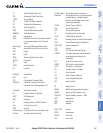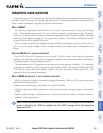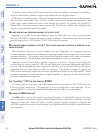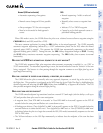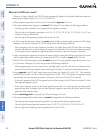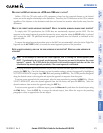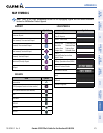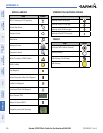
190-00595-01 Rev. B
Garmin G1000 Pilot’s Guide for the Beechcraft A36/G36
SYSTEM
OVERVIEW
FLIGHT
INSTRUMENTS
EIS
AUDIO PANEL
& CNS
FLIGHT
MANAGEMENT
HAZARD
AVOIDANCE
AFCS
ADDITIONAL
FEATURES
APPENDICES INDEX
469
APPENDIX D
FREQUENTLY ASKED QUESTIONS
If a particular aspect of G1000 operational capability is not addressed by these commonly asked questions or in
the index, contact Garmin (see the copyright page or back cover for contact information) or a Garmin-authorized
dealer. Garmin is dedicated to supporting its products and customers.
WHAT IS WAAS?
The Wide Area Augmentation System (WAAS) uses a system of ground stations to correct any GPS signal
errors. These ground stations correct for errors caused by ionospheric disturbances, timing, and satellite
orbit errors. It also provides vital integrity information regarding the health of each GPS satellite. The signal
correction is then broadcast through one of two geostationary satellites. This correction information can then
be received by any WAAS-enabled GPS receiver.
WAAS is designed to provide the additional accuracy, availability, and integrity necessary to enable users to
rely on GPS for all phases of flight. WAAS is currently available in the United States, including Alaska and
Hawaii.
HOW DOES WAAS AFFECT APPROACH OPERATIONS?
Both LNAV/VNAV and LPV approaches use the accuracy of WAAS to include vertical (glide path) guidance
capability. The additional accuracy and vertical guidance capability allows improved instrument approaches to
an expanded number of airports throughout the U.S.
The implementation of LPV approaches further improves precision approach capabilities. LPV approaches
are designed to make full use of the improved GPS signal from the WAAS. This approach combines the LNAV/
VNAV vertical accuracy with lateral guidance similar to the typical Instrument Landing System (ILS). LPV
approaches allow lower approach minimums.
WHAT IS RAIM AND HOW DOES IT AFFECT APPROACH OPERATIONS?
RAIM is an acronym for Receiver Autonomous Integrity Monitoring. RAIM is a GPS receiver function that
performs the following functions:
• Monitors and verifies integrity and geometry of tracked GPS satellites
• Notifies the pilot when satellite conditions do not provide the necessary coverage to support a certain phase
of flight
• Predicts satellite coverage of a destination area to determine whether the number of available satellites is
sufficient to satisfy requirements
NOTE
: If RAIM is not predicted to be available for the final approach course, the approach does not become
active, as indicated by the “RAIM not available from FAF to MAP” message and the LOI annunciation
flagging on the HSI.



